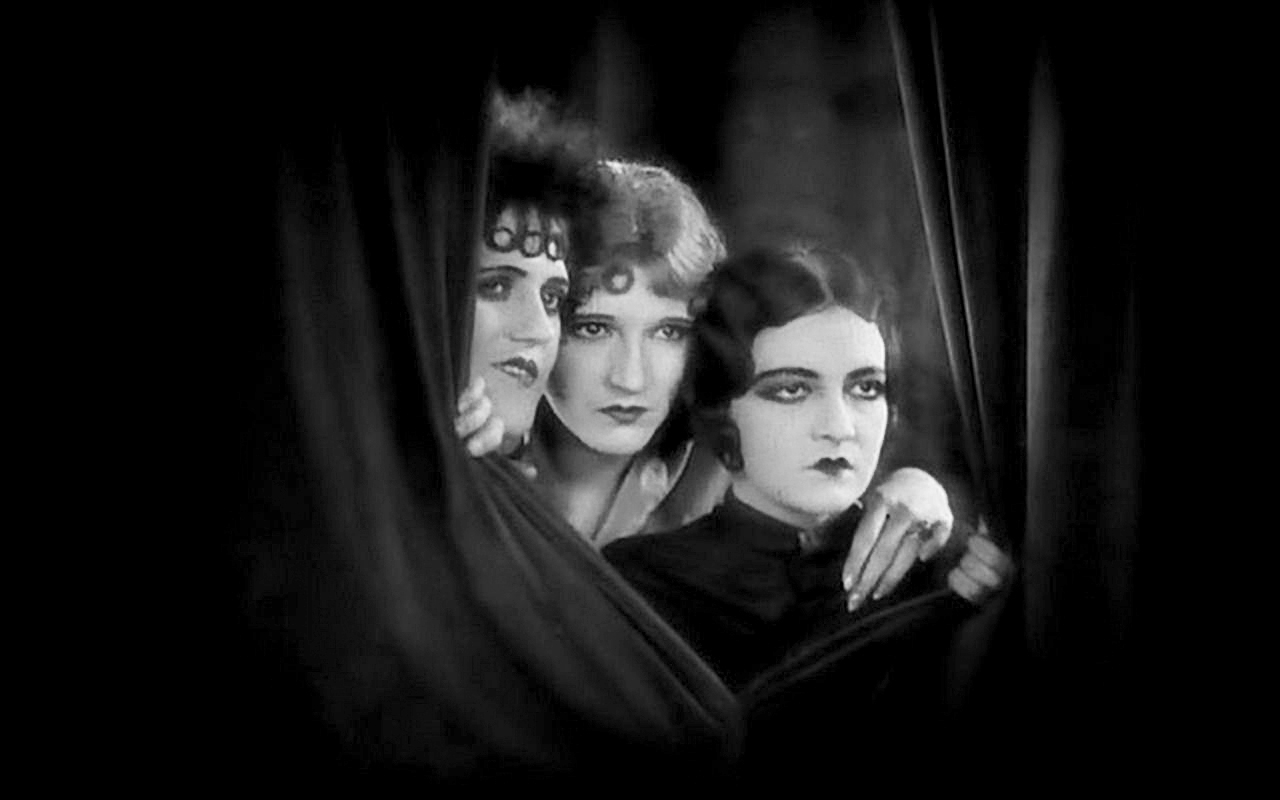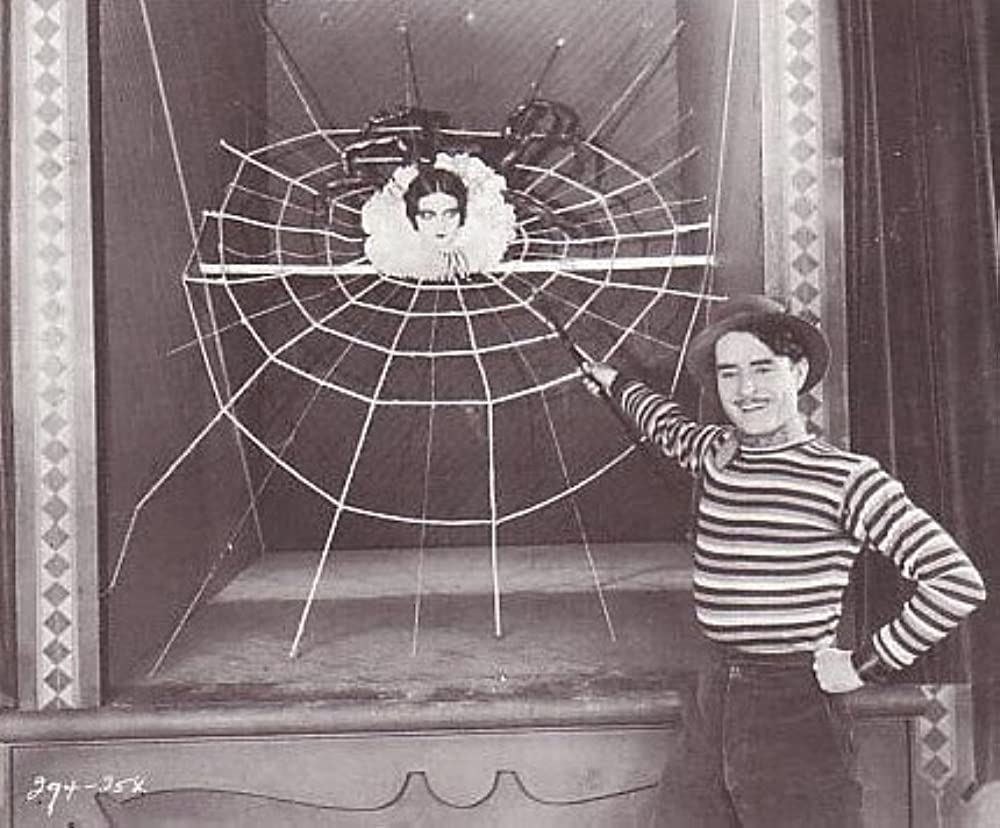
Tod Browning is best known for directing creepy, silent films such as Freaks and Dracula, but before he made movies, he was a circus performer and carnival sideshow host. Perhaps that’s what makes the images in The Show so compelling.
Cock Robin hosts a vaudeville sideshow in Budapest. Magicians perform stunning acts that dazzle the crowd; freaks of all kinds parade across the stage; the talented Salome acts out an entire scene. The most notable of these acts include Arachnida, the lady with a human head and spider body, the disembodied hand, the half lady, and the apparent beheading of our own Cock Robin right on stage. This is simply christened, “The Show”. The Show is so popular that people can’t get enough. They throw money at the tickets, and themselves at Robin. He regularly entertains his groupies and enjoys the prestige.
Robin was once involved with Salome, who still desires a romantic relationship with him, but now he has decided to pursue things with Lena, a sheep farmer’s daughter. Salome’s current boyfriend, The Greek, is our villain. He and his henchmen are after Lena’s father’s money, and murder him, only to fail to find his money. A second murder takes place that same night.

Salome intentionally sabotages Robin’s relationship with Lena, and what ensues might make audiences today think he is definitely the villain, not The Greek, as he comes within inches of beating Salome. Meanwhile, another act takes place at the sideshow: a poisonous lizard is paraded about, said to be imported from Africa, and of course, The Greek steals it from The Show.
Another odd detail emerges: in Salome’s building, there is an old man who is blind and is waiting for his son to return from war. Salome reads his son’s letters to him, only to reveal to Robin that the son is actually being held in the prison across town, and will be hanged in the morning. The old man hears Robin and Lena talking, and believes his son has come home. A visibly uncomfortable Robin lets the old man become very emotional, as we see his real son being publicly hanged from the window.
The final climactic scene involves a confrontation between the police, Salome, Robin, The Greek, and of course, the poisonous lizard. And while the ending is a bit horrifying and violent, the final product is still primarily happy, with the leads reconciled and The Show going on.
What’s interesting about this film is that its current fandom, or otherwise mention in silent film groups, has very little to do with the actual plot or characters, and more to do with the freaks in the sideshow. The aforementioned Freaks is a bit similar – the images that have stayed with audiences, almost a century later, are the strange bodily mashups Browning gives us. The arachnid lady is only in one very brief scene, in the first few minutes, and never mentioned again, yet is the most iconic image of the film.

The production values are high quality. The acting is surprisingly nuanced, especially given the fact that there is no auditory dialogue or sound. The leads (John Gilbert and Renee Adoree) both manage to portray complex emotions and give depth and layers to their respective characters, with only body language and facial expressions. The old man (billed as The Soldier), Edward Connelly, evokes strong sympathy and tragedy. The Greek (Lionel Barrymore) also makes it incredibly easy to hate him, as the villain. The cinematography is strong, if not impressive, for the time. The images of what is supposed to be Budapest are a bit distracting, given that they look nothing like it, but one has to suspend disbelief a bit here. Of course, what’s really impressive are the special effects, and the images of the sideshow itself.
Thematically, there are a few ways to interpret this film. Tod Browning himself loved the creepy and macabre, both on stage and behind the camera, and that comes across clearly in the movie. We, as the audience watching the film, are very clearly meant to see ourselves in the audience watching the vaudeville sideshow. It feels a bit like Shakespeare’s The Tempest, that the fictitious audience reflects the real one, wanting to be fooled by the magic tricks, wanting to be frightened and creeped out. The most unsettling scene is one in which The Greek prepares to murder Robin by actually chopping his head off during The Show, the audience being none the wiser because they will believe it’s fiction.
Is it scary? It’s definitely creepy, and both the aforementioned scene and the final climactic confrontation are intense. The image of The Soldier weeping with joy because his son is finally home, mashed up with his real son being executed publicly, is definitely disturbing and will stay with audiences. The images of the vaudeville freaks will most likely tickle and delight rather than frighten, but seeing as how some audiences were very frightened by Freaks, it’s possible that certain folks will be frightened here, too.
Overall, I would not say that this is Browning’s best (although that is indeed a tough competition), but it’s a fun carnival ride all of its own, with some interesting commentary on the nature of horror and its aficionados, of both stage and screen.

More Film Reviews
Alongside their dedicated Shorts Showcase (both Canadian and International), the Toronto After Dark Film Festival offers bitesize extras for those attending. Each of the main features is preceded by a… Eichi Sato, known better in the following years for his work on the live-action adaptations of Lychee Hikari Club (2016) and Miso Misou (2018), found his way to shock us… Struggling to quit smoking, Piotrek’s fiancée signs him up for a course at an institute focused on providing help for men. However, after a room mix-up, he finds himself in… Japan seems to have nailed the absurdist comedy, whether that’s big budget to small indie features, no other country is comparable in wit at embracing the peculiar. Available at Japan… *Disclaimer: Featured image is, in fact, probably not Misfits Era Glen Danzig In a darkened room a shrouded figure tells a group of kids three scary tales. “Satan’s Necklaces” follows… Raging Grace outlines the exploitation and fetishisation of undocumented immigrants whilst simultaneously celebrating distinctive Filipino traditions and cultural heritage. Paris Zarcilla’s incisive directorial debut follows single mother Joy as she…TADFF 2023 Canadian Shorts (Pre-features) [Toronto After Dark Film Festival]
Let’s Make the Teacher Have a Miscarriage Club (2011) Film Review – Exactly what it says on the tin
Alpha Male (2022) Film Review – The Absurd Temple of Bromanity!
I, Dolphin Girl Film Review – Supersonic Head Explosions!
Scary Tales (1993) Film Review – I Ask You! Are You Not Afraid?
Raging Grace (2023) Film Review – Horror and Social Commentary in Unsettling Harmony [FrightFest]
Voting member of the Independent Spirit Awards. Charter subscriber to the Criterion Channel. Silent and pre-code horror enthusiast. In my “real” life, I’m a human rights activist, social scientist, and burlesque performer
![TADFF 2023 Canadian Shorts (Pre-features) [Toronto After Dark Film Festival]](https://www.grimoireofhorror.com/wp-content/uploads/2023/10/Untitled-design-18-365x180.jpg)




![Raging Grace (2023) Film Review – Horror and Social Commentary in Unsettling Harmony [FrightFest]](https://www.grimoireofhorror.com/wp-content/uploads/2023/08/MV5BZWIyYWJmODktYTg0Yi00YzQ5LTkyNjEtNmE3OWZkYjBhMzc1XkEyXkFqcGdeQXVyMTE0MzQwMjgz._V1_-365x180.jpg)